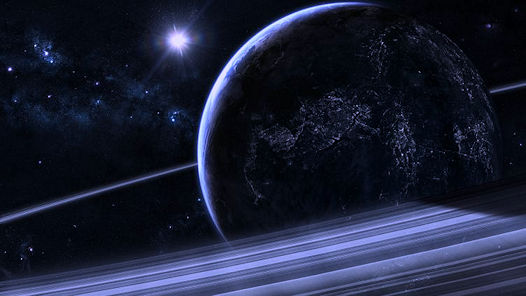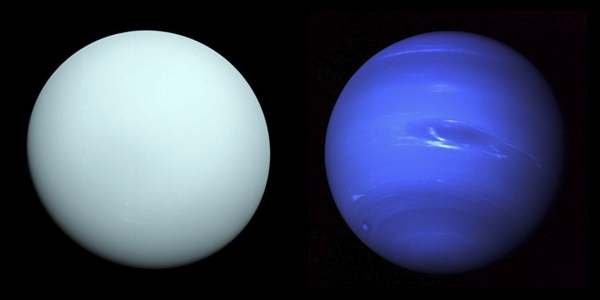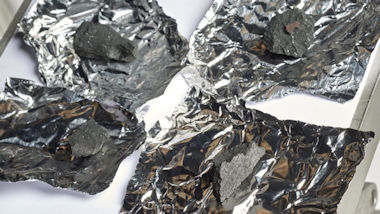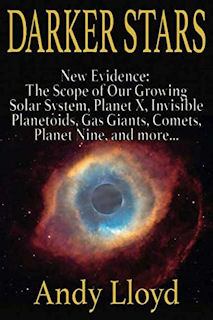Andy Lloyd's Dark Star Blog

Blog 90 (July-September 2022)
Stealing Gas Giants

We've become used to the plethora of bizarre exoplanets out there in the Milky Way. Many have defied previously held theories of planet formation. While a lot of these mavericks have been found located ridiculously close to their parent stars (for example, the 'hot Jupiters'), others have been found in the back of beyond. Only loosely bound to their stars, these planets roam the outer fringes of their planetary systems - in a zone where they should not have had any chance of forming in the first place.
Finding substantial planets, like gas giants and sub-brown dwarfs, hundreds of astronomical units from their stars challenges astrophysicists to explain their existence. Various ideas have been presented, ranging from planetary migration to capture of free-floating planets ejected by other stars during the maelstrom of their own planet-forming epochs. It was once thought statistically unlikely that a planet could be captured by a star, but the prevalence of these outliers has questioned that received wisdom. For capture to work as a common-place scenario, there would need to be a vast amount of planet-sized debris floating around in interstellar space.
Adding support to the exoplanet capture scenario is the existence of wide-orbit gas giants orbiting massive stars. Because massive stars emit a huge amount of ultraviolet radiation, gas giants stand little chance of forming in their midst; their voluminous atmospheres are simply ripped away by the higher energy emissions from the massive stars leading to planetary disintegration. This obviously impedes the 'normal' growth of such planets through accretion, an effect that starts to be seen from stars with about twice the mass of our Sun upwards:
"Earlier studies of planets in close-in orbits around high-mass stars have revealed an increase in giant planet frequency with increasing stellar mass until a turnover point at 1.9 solar masses, above which the frequency rapidly decreases." (1)
Because of this, it's hard to see how a migration scenario could explain the existence of gas giants located hundreds of astronomical units from larger stars: These planets don't even have a chance of getting going around their massive parent stars.
New research published by a team from the University of Sheffield has indicated that "planets on more distant orbits (more than 100 times the distance from Earth to Sun) may not be orbiting their parent star” (2). Using computer simulations of the comings and goings of nascent planets in dense star-forming regions, the team showed that many were either captured from interstellar space, or stolen directly from neighbouring star systems. Further, the orbital parameters of a given wide-orbit exoplanet might provide a clue as to whether it's home-grown, found or stolen. This is because the computer simulations provide a divergence in orbital characteristics depending upon the planet's origin:
"The semimajor axis distribution of captured planets is significantly skewed to wider orbits compared to the semimajor axis distribution of stolen planets and planets that are still orbiting their parent star (preserved planets)." (3)
In our own solar system, any still-to-be-discovered Planet X body could fall into this category. Once, Planet X sceptics could question whether such a world could even exist in practice - but not any more.
Written by Andy Lloyd, 8th September 2022
References:
1) Markus Janson et al. "A wide-orbit giant planet in the high-mass b Centauri binary system" Nature, 600, 231–234, 8 December 2021
nature.com/articles/s41586-021-04124-8
2) University of Sheffield Press Release "Planetary heist: astronomers show massive stars can steal Jupiter-sized planets" 7 Sept 2022
3) Emma Daffern-Powell, Richard Parker & Sascha P Quanz "The Great Planetary Heist: theft and capture in star-forming regions" Monthly Notices of the Royal Astronomical Society, July 2022, 514(1): 920–934
JWST Analyses Brown Dwarf Atmosphere
Because the James Webb Space Telescope can view objects in infrared, it is a hoped-for springboard for future brown dwarf research. Even in these early days, Webb is proving this to be true.
The phenomenally powerful space telescope was recently trained upon a brown dwarf, which was first discovered in 2015, named VHS 1256-1257 b. It's located 72 light years away - a relative cinch for this telescope which has been delving into the archaic depths of the universe. The brown dwarf orbits its parent star at a distance of about 150 astronomical units (a very wide-orbit 'planet') and is less that 20 Jupiter masses (2).
The results of the analysis of the spectrum of infrared light from the brown dwarf are not particularly surprising in themselves; the data simply confirms what had been previously posited. The atmospheric composition was similar to other brown dwarfs, consisting of:
"...methane, sodium, water, potassium and carbon dioxide. And they also found clouds, which they believe are made of silicate particles. The clouds... formed in thick layers [which] are probably made of some type of mineral, such as enstatite, quartz or forsterite. The researchers note that their observations confirm theories that brown dwarfs can be encircled by dusty clouds, which, they further note, can have an impact on their brightness." (3)
The latter point is an important finding. This brown dwarf has an atmosphere infused with silicate dust:
"As an L-to-T transition object, VHS 1256 b exists along the region of the color-magnitude diagram where substellar atmospheres transition from cloudy to clear... We directly detect silicate clouds, the first such detection reported for a planetary-mass companion." (2)
Written by Andy Lloyd, 8th September 2022
References:
1) Alex Wilkins "JWST has spotted sandy clouds on a distant alien world" 2 September 2022
2) Brittany E. Miles et al. "The JWST Early Release Science Program for Direct Observations of Exoplanetary Systems II: A 1 to 20 Micron Spectrum of the Planetary-Mass Companion VHS 1256-1257 b." Submitted to AAS Journals, 1 September 2022
3) Bob Yirka "Webb telescope finds brown dwarf with dust clouds in its atmosphere" 6 September 2022
Water Worlds Prevalent around Red Dwarfs
Image Credit: Pilar Montañés
You might expect most terrestrial planets orbiting near to their stars would be dry. With the exception of Earth, that's what we see in the solar system, after all.
It's in our collective human nature to think of ourselves as being exceptional - the centre of the universe - and so the idea that Earth is somehow uniquely placed to seed life has been a steadfast bedrock of scientific knowledge. Or, at least, a default position which must be disproved. The solar system presents us with this: Terrestrial planets are dry, like Mercury, Venus, the Moon, Mars. Earth has water. Therefore, we conclude that most inner planets are dry and Earth somehow bucks the trend. Lucky us.
Except... well, that's just science extrapolating a small sample size to a universal generalisation - something every student of science is scolded for doing. Who's to say that, in this diminutive sample size, it's not Venus and Mars that are quirky? Perhaps Earth is the 'normal' one here.
The theory of planet formation through accretion tends to disfavour volatiles becoming substantive ingredients in the planet-making mix. Warm, young stars blow the lighter gases (like water vapour) away. To explain Earth's water, astronomers have invoked the arrival of water-bearing comets - impacting Earth and lacing its surface with oceans. Geophysicists prefer the idea that Earth's water started within the planet and gradually worked its way out in the same way as its primordial atmosphere. In recent times, the geophysicists have been sneaking ahead in this debate.
To add more grist to their inner workings mill, recent studies (1, 2) of exoplanets orbiting red dwarfs (M-dwarfs in the jargon) have indicated a likely watery character to many of them.
"The densities of a large percentage of the planets suggested that they were too light for their size to be made up of pure rock. Instead, these planets are probably something like half rock and half water, or another lighter molecule. Imagine the difference between picking up a bowling ball and a soccer ball: they're roughly the same size, but one is made up of much lighter material." (3)
Bear in mind that this study is for red dwarfs, which are cooler stars than the yellow dwarfs like our Sun. As a result, there's less solar energy being blasted out towards the early protoplanetary disk where the nascent planets are forming. Water is less likely to be driven off. Even so, scientists weren't expecting so much of it to survive in these inner terrestrial planets. The sample size here is 43, roughly ten times that of our own solar system.
Interestingly, a throw away line at the end of the press release says this:
"The finding matches a theory of exoplanet formation that had fallen out of favor in the past few years, which suggested that many planets form farther out in their solar systems and migrate inward over time. Imagine clumps of rock and ice forming together in the cold conditions far from a star, and then being pulled slowly inward by the star's gravity." (3)
Could a period of inner migration apply to Earth and its neighbours? This has been a theme of this blog (and my books) for a while, and some well-placed astrophysicists have begun arguing the same recently (4).
Image credit:
Sean Raymond
Admittedly, this is not quite the same as saying the whole planet migrates fully formed, but an inward movement of the planetessimals and other planetary building blocks seems perfectly possible, whether as a result of a natural process or catastrophism. This potentially knocks down another anthropocentric myth of Earth's immutability.
Written by Andy Lloyd, 14th September 2022
References:
1) Rafael Luque & Enric Pallé "Density, not radius, separates rocky and water-rich small planets orbiting M dwarf stars" Science, 377 (6611): 1211-4, 8 September 2022
science.org/doi/10.1126/science.abl7164
2) Johanna Teske "Three types of planets orbit red dwarfs" Science, 377 (6611): 1156-7, 8 September 2022
science.org/doi/10.1126/science.add7175
3) University of Chicago "Surprise finding suggests 'water worlds' are more common than we thought" 8 September 2022
4) Andy Lloyd "Earth's Inward Migration" 30th June 2022
andylloyd.org/darkstarblog89.htm
Are Uranus and Neptune 'Rock Giants'?

Occasionally, my Twitter feed (@darkstarandy) picks up a little gem. In this case, a big rock!
We're used to the concept of 'ice giants': Uranus and Neptune are massive planets in the outer solar system that are through to be made up predominantly of ices. Both have thick, impenetrably opaque atmospheres which have never been explored directly. Apart from the historic visits by Voyager 2 (which flew past Uranus in 1986 and Neptune in 1989), both worlds have received scant attention from space probes - largely due to the ridiculous time and effort (and money) required to get there. Of course, the chemical signatures of their atmospheric gases have been ascertained from spectrometry, and that provides some good data about the planets' outer atmospheres. Also their volumes and masses have been figured out, providing an idea about their densities. These measurements give clues as to what the planets are made of, supplemented by a raft of theoretical work about the interiors of these cold, distant worlds.
Even so, we don't know for sure what they're made of...
This month, this topic was aired at the Europlanet Science Congress 2022 where astronomer Nick Teanby discussed an alternative to the currently accepted 'ice giant' hypothesis (1). He had co-authored a paper in 2020 which had considered whether the planets might instead be 'rock giants' (2). A lot of their analytical work revolved around measurements of carbon monoxide in Neptune's troposphere, as well as good old hydrogen/deuterium isotopic ratios. It seems that the current constraints from the available data leave the door open to the possibility that these huge worlds may have a substantial amount of rock in their composition. Who knew? Well, no one outside the academic community, it seems. This idea is speculative, after all - but the argument around this has been simmering away for a few years in the astronomy community. There may be some sense to it, as Teanby argues in the 2020 paper:
"An interior with more rock than ice is also more compatible with likely outer solar system ice sources. ... While both ice- and rock-dominated models are viable, we suggest a rock giant provides a more consistent match to available atmospheric observations." (2)
This is potentially a radical departure from the received wisdom about Uranus and Neptune. If this case were proven (by, say, a long-overdue visit) both worlds would become Rock Giants. Perhaps our old friend Planet X might be similarly composed? In which case, would this distant rock giant be more appropriately named 'Deep Purple'??
Anyway, it's interesting to note that there is a precedent for a 'rock giant' exoplanet. There's a world out there (730 light-years out there...) that is 40 times as massive as Earth and composed entirely of rock. It seems to be the giant core of a 'hot Jupiter' which has had its massive atmosphere stripped away:
"The roasted world known as TOI-849b is the most massive rocky planet ever observed, with as much as 40 Earths’ worth of material crammed inside. Perplexingly, TOI-849b’s tremendous bulk suggests that it should be a giant, gassy world like Jupiter, yet it has almost no atmosphere." (3)
As interesting as this is, TOI-849b is clearly nothing like Uranus or Neptune. But that's not to say that our solar system neighbours might have a lot more rock in them than ice.
Written by Andy Lloyd, 19th September 2022
References:
1) Europlanet Science Congress 2022, Granada 18–23 September 2022
2) Nick Teanby et al. "Neptune and Uranus: ice or rock giants?" Philosophical Transactions of the Royal Society A, 378 (2187) 9 November 2020
royalsocietypublishing.org/doi/epdf
3) Nadia Drake "Bizarre new planet is largest known rocky world, 40 times as massive as Earth" 1 July 2020
nationalgeographic.com/science/article
UK Meteorite Evidences Water from Asteroids

Image credit:
Natural History Museum
A lot of good science can be done on space rocks that have landed on Earth. The problem is that meteorites can get contaminated (particularly by water) if left around for a while before being found by humans. That's why it's so important to scientists if meteorites can be found shortly after their meteoric plunge through the atmosphere sensationally lights up the sky.
So, when a meteor was spotted by multiple sources crossing the UK skies in February 2021 the race was on to find whatever remnants, if any, made it to the ground. Thanks to the work of the 'Fireball Alliance', the trajectory of the meteor was tracked and an approximate landing site extrapolated. And, rather delightfully, the resulting meteorite was found sitting on a driveway in Winchcombe, Gloucestershire (1). Admittedly, not exactly Chicxulub - more like the coalman dropped a few briquettes on the drive during his delivery! However - and Maggie Thatcher can take a bit of credit here - the homeowners did not confuse this extraterrestrial package for solid fuel, and duly alerted the good men and women of science.
Because all of this took place within 12 hours, the meteorite fragments were not contaminated by their new earthly environment. Subsequent analysis of the precious space rock indicated a carbonaceous chondrite rock which likely originated from the asteroid belt near Jupiter. There's water in the meteorite, and its D/H signature is a close match for Earth water. This is in common with asteroids in the outer asteroid belt.
If water from Earth originated from impactors, then it's the asteroids that we can credit for our oceans rather than the comets:
"...data from missions to comets suggest they are not a good match for the water on earth: "The composition of the water in Winchcombe is a much better match, so that would imply that asteroids - carbonaceous asteroids - were probably the main source of water to the inner solar system, to the Earth." [explained Dr Ashley King of the Natural History Museum]" (2)
But, as regular readers of this blog will appreciate, that's not necessarily the whole story. Anyway, this story is a local one for me personally - I live about 15 miles from Winchcombe. So, it could just as easily have been my driveway which played host to this extraterrestrial visitation. Alan Alford would have been proud.
Written by Andy Lloyd, 21st September 2022
References:
1) Tammana Begum "From field to Vault, how the largest Winchcombe meteorite was found" 5 October 2021
2) Lucia Binding "Extra-terrestrial water found for first time in meteorite that landed in UK" 17 September 2022, with thanks to Lee


